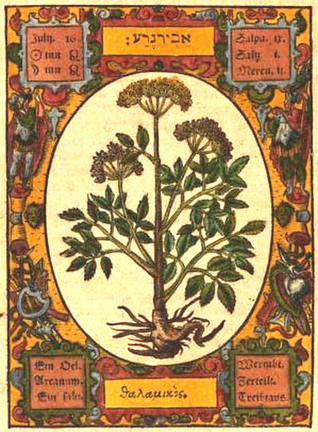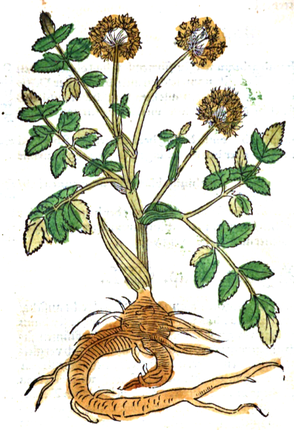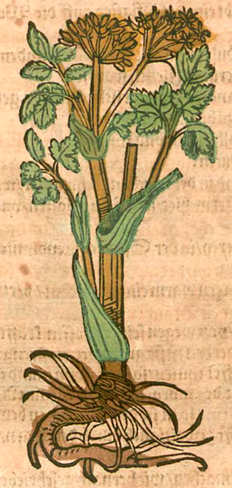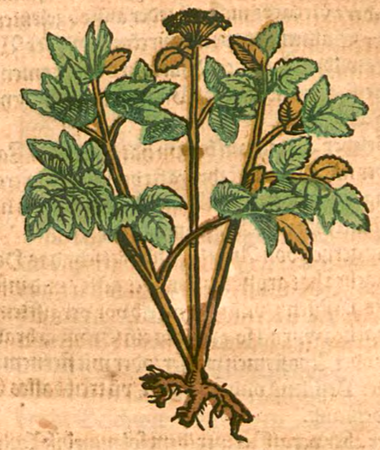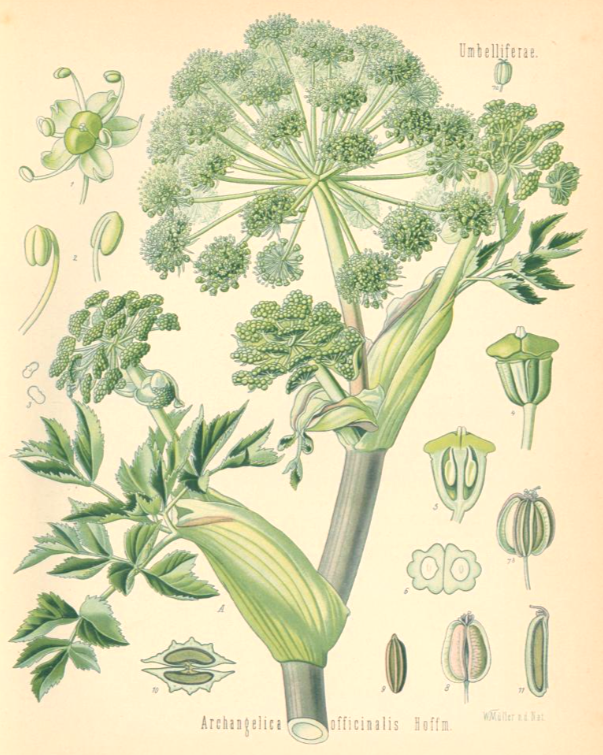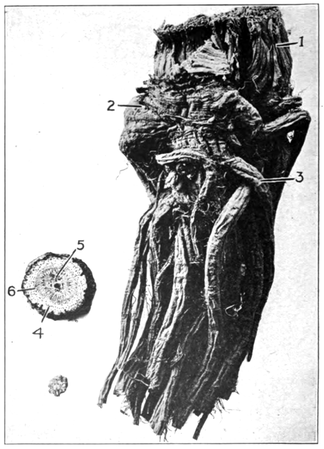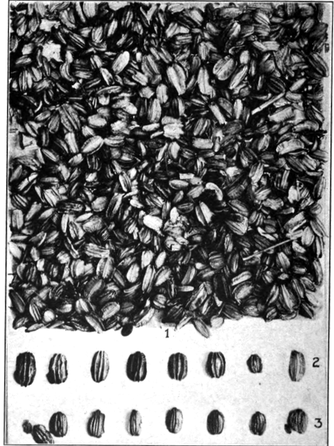Sentry Page Protection
Angelica
Canda (Unani)
Historia unnd Beschreibung Influentischer, Thurneisserus, 1578
Krauterbuch, Rihel, 1565
Left: Angelica sativa; Right: Angelica sylvestris
Krauterbuch, Lonitzer, 1578
Krauterbuch, Lonitzer, 1578
Kohlers Medizinal Pflanzen, Vol. 2, 1888
Angelica root
Notes on Pharmacognosy, Otto Augustus Wall, 1902
Notes on Pharmacognosy, Otto Augustus Wall, 1902
LEFT: EUROPEAN ANGELICA ROOT; RIGHT: ANGELICA SEED
Squibb's Atlas of the Official Drugs, Mansfield, 1919
Squibb's Atlas of the Official Drugs, Mansfield, 1919
Botanical name:
Angelica archangelica
Several Wild species were also used synonymously with the 'Garden' Angelica.
Angelica glauca is used in Tibetan Medicine. It has similar properties and uses to A. archangelica, and several sources have stated that the latter is harvested indiscriminately with A. glauca. Seeing that A. glauca is endangered, A. archangelica can be used in its place.
Parts used:
Root; also the Seed
Temperature & Taste:
Warm, dry. Pungent
Opens, attenuates
Classifications:
3A. SUDORIFICS & DIAPHORETICS. 3C. ALEXIPHARMICS. 3D. CORDIALS & CARDIACS. 3G. EMMENAGOGUE. 3K. EXPECTORANT
3P. MASTICATORIES & STERNUTATORIES.
4c. CARDIAC. 4i. UTERINE
Angelica archangelica
Several Wild species were also used synonymously with the 'Garden' Angelica.
Angelica glauca is used in Tibetan Medicine. It has similar properties and uses to A. archangelica, and several sources have stated that the latter is harvested indiscriminately with A. glauca. Seeing that A. glauca is endangered, A. archangelica can be used in its place.
Parts used:
Root; also the Seed
Temperature & Taste:
Warm, dry. Pungent
Opens, attenuates
Classifications:
3A. SUDORIFICS & DIAPHORETICS. 3C. ALEXIPHARMICS. 3D. CORDIALS & CARDIACS. 3G. EMMENAGOGUE. 3K. EXPECTORANT
3P. MASTICATORIES & STERNUTATORIES.
4c. CARDIAC. 4i. UTERINE
Uses:
1. Clears Wind-Cold, Resists Poison:
-Cold, Flu, Acute Fever
-used to prevent and treat Plague, Infectious and Epidemic diseases
-Venom including bites of Rabid Dogs
-‘It expelleth Wind that is in the body, and easeth the pain that cometh from the same’. (Culpeper)
-Wind-Cold pains: Headache, Migraine, Neuralgia, Arthritis, Lumbago, Sciatica
2. Clears Phlegm, Stops Cough:
-Cough, Chronic Bronchitis, Asthma, Pleurisy
-the root chewed cleanses the Chest and stops chronic Cough (Herbarium Horstianum, 1630)
3. Cordial and Cardiac:
-'Cheers the Heart, Revives the Spirits'.
-'expels all infection from the Heart'
4. Moves the Blood, Promotes Menstruation
-Amenorrhea, Dysmenorrhea
-Promotes Birth
-'suffocation of the Uterus'
-Seed has been used to promote Fertility
5. Warms the Stomach:
-Indigestion, poor Appetite, Colic
6. Clears Damp, Promotes Urine:
-strangury, painful urine, stoppage of Urine
7. Externally:
-internally and topically for Wounds and old Ulcers
-ointment is beneficial for the Skin (like Dang Gui)
-distilled water is dropped into the eyes for dimness of sight
-plaster was applied to venomous Bites
-plaster or poultice can be applied to the chest or upper back for Bronchitis and Pleurisy
PREPARED ROOT (Candied):
1. Nourishes Liver and Blood:
-Blood tonic in female weakness, anemia
-Infertility
-chronic joint diseases with weakness: Arthritis, Lumbago etc.
2. Resists Poison:
-regarded as stronger to prevent infection during Epidemics
Dose:
Powder: 1–3 grams
In decoction: 3–9 grams
Substitute:
1. Blessed Thistle; ‘much like it in vertue, that if the one be wanting, the other may be taken’ (Culpeper).
2. For acute diseases, and to preserve from infection Angelica Bai Zhi of TCM may be used.
3. As a tonic, and for menstrual disorders, Angelica Dang Gui may be used.
4. Lovage (Levisticum officinale) and Burnet Saxifrage (Pimpinella saxifraga) were listed as being similar in function and use in King’s American Dispensatory. (1898)
Powder: 1–3 grams
In decoction: 3–9 grams
Substitute:
1. Blessed Thistle; ‘much like it in vertue, that if the one be wanting, the other may be taken’ (Culpeper).
2. For acute diseases, and to preserve from infection Angelica Bai Zhi of TCM may be used.
3. As a tonic, and for menstrual disorders, Angelica Dang Gui may be used.
4. Lovage (Levisticum officinale) and Burnet Saxifrage (Pimpinella saxifraga) were listed as being similar in function and use in King’s American Dispensatory. (1898)
Main Combinations:
Angelica & Zedoary
Acute Diseases, Against Poison
1. Acute Cold or Flu:
i. Angelica with Elder flower
ii. Angelica, Peppermint, Thyme
2. Acute, Epidemic Cough:
i. Angelica with Licorice, Elecampane, Orris, Flowers of Sulphur
ii. Angelica, Thyme, Hyssop
3. Catarrh:
i. Angelica, Eyebright
ii. Angelica with Eyebright, Yarrow, Thyme
4. To preserve against infection:
i. Angelica with Pleurisy root, Valerian, Polypody, Marshmallow, Nettle (as in Saxonian Powder)
ii. Angelica with Gentian, Tormentil, Zedoary, Citron peel, Licorice (as in Troches Resisting Poison)
iii. Angelica with Gentian, Tormentil, Clove, Nutmeg
iv. against Poison and Infection, Angelica with Tormentil, Blessed Thistle (as in Powder Against Toxicity and Venom)
5. Spotted Fevers:
i. Angelica with Bistort and Zedoary
ii. Mumps, Angelica, Centaury, Yarrow
Gynecology
6. To promote Menstruation, with Cyperus, Valerian, Madder, Mugwort, Pennyroyal (as in Emmenagogue Decoction of Riverius)
7. As a tonic to Mother and Child, Angelica with Peony root, Pearl and Red Coral and a little Cassia Wood
8. Infertility, combine Angelica seed, Fennel seed Licorice, Raisin, Mugwort Balm, Blessed Thistle, Pennyroyal (as in Water Making Fruitful)
Head and Brain
9. To strengthen the Heart and Vital Spirits (Qi):
i. Angelica with Aniseed, Coriander seed, Caraway seed and Zedoary (as in Angelica Water)
ii. Angelica with Rosemary, Elder flower, Balm, Citron peel, Saffron
10. Lethargy, Angelica with Savory, Thyme, Pennyroyal
11. Alzheimer's Disease: Angelica and Asafetida (see research below)
Other
12. Gastric Ulcers, Angelica with Balm, Camomile, Peppermint, Licorice
13. Headache from Wind-Cold with Blood stagnation, or to promote Menstruation, Angelica with Lovage
14. Trauma and Wounds, Angelica with Agrimony, Mugwort, St. Johns wort, Southernwood, Betony, Bugle, Comfrey, Plantain (as in Decoction for Wounds)
Major Formula:
Emmenagogue Decoction (Riverius)
Decoction for Wounds
Saxonian Powder
Troches Resisting Poison
Powder Against Toxicity and Venom (Wecker)
Electuary of Eggs (Maximilian)
Tincture of Angelica Seed
1.. Alexipharmic Water:
i. Angelica leaf, Sea Wormwood (each 4 oz.), Mint (half pound), Proof Spirit (16 pounds), Water, sufficient. Distil off 16 pounds. (Niemann)
2. Compound Spirit of Angelica:
Stimulant, sudorific, diuretic, anti-spasmodic. (Dose: 30–60 drops)
i. Angelica root (1 pound), Scordium (half pound), Valerian, Juniper (3 oz.), Alcohol (6 pounds), Water (3 pounds). Distil 3 pounds and add Camphor (1 ½ ounce) (Pharmacopoeia Oldenburgica, 1801)
ii. Juniper, Valerian (1 part each), Scordium (2 parts), Angelica root (4 parts), Proof Spirit (30 parts), Water (60 parts). Distil 24 parts and add Camphor (half part) (Pharmacopee Usuelle, Louvain, 1821)
iii. Angelica, Masterwort, Serpentaria, Zedoary (1 oz.), Scordium (2 oz.), Lemon peel, Juniper, Myrrh (1 oz.), Saffron (½ oz.), Theriac (½ pound), Proof Spirit (7 pounds). Distil 4 pounds and ad Camphor (1 scruple) (Pharmacopoeia Sardoa, 1773)
3. Epidemic Water of London (Aqua Epidemica Londinensis):
i. Angelica root, Tormentil, Gentian, Zedoary, Licorice, Celandine, Rue, Sage, Mugwort, Wormwood (each 1 oz.), Pimpernel, Scabious, Tarragon, Agrimony, Scordium, Lesser Centaury, Blessed Thistle, Betony, Sun Dew (1 oz.), White Wine (12 pounds); macerate, distil. Dose: 1–2 oz. (Pharmacopoeia Wirtembergica, 1798)
4. Bezoardic Water / Tincture:
i. Angelica, Elecampane, Burnet Saxifrage, Carline Thistle, Contrayerva, Swallow-wort, Fraxinella, Masterwort, Valerian (equal parts)
(Pharmacopoeia Generalis, 1783)
ii. Angelica, Elecampane (1 oz.), Carline Thistle root, Fraxinella (1 oz.), Myrrh (6 drams), Saffron (2 drams), Alcohol (40 oz.) (Pharmacopoeia Wirtembergica, 1798)
5. Prophylactic Water:
i. Angelica root, Zedoary (1 oz.), Butterbur (2 oz.), fresh Lemon sliced (1 pound), Rue (4 oz.), Balm, Scabious, Calendula (2 oz.), Green Walnuts, sliced (2 pounds), Vinegar (12 pounds); digest overnight, then slowly distill to dry. (Sylvius)
6. Compound Vinegar of Angelica:
i. Angelica root (1 ounce), Rue, Peppermint, Rosemary, Lavender (half ounce), Vinegar (3 pounds); steep, press, filter, and add alcohol (1 ½ ounces)
ii. Angelica, Masterwort (1 ½ oz.), Peppermint, Rosemary, Rue, Sage (2 oz.) Lavender (3 oz.), Vinegar (7 pounds); macerate 6 days, shaking often then strain. (Pharmacopoeia Amstelodamensis, 1792)
iii. Angelica, Valerian, Sage, Peppermint, Juniper berry (1 oz.), Vinegar (4 pounds); digest, strain, filter, then add Alcohol (2 oz.)
iv. Angelica, Butterbur (3 oz.), Scordium, Rue (1 ½ oz), Lemon peel (4 oz), Myrrh (6 drams), Vinegar (7 pounds); digest, strain, filter, and add Camphor (half ounce) (Pharmacia rationalis, 1806)
v. Angelica (1 pound), Wormwood (1 ½ ounce), Garlic (½ ounce), Vinegar (8 pounds); digest warm for 8 days, strain and press, then add Camphor (half ounce) dissolved in Spirit (Pharmacopoeia Suecica, 1817)
vi. Angelica, Masterwort (½ ounce), Wormwood, Rue, Mint, Sage, Rosemary, Lavender (each 2 oz.), Garlic (2 drams), Vinegar (8 pounds); digest, strain and filter. Camphor (half ounce) can be added. (Pharmacopoeia Rossica, 1803)
7. Carminative Spirit:
i. Seeds of Angelica, Anise, Coriander (½ oz.), Cinnamon (6 drams), Peppermint, Marjoram, Rosemary (2 drams), Nutmeg, Mace, Angelica root, Lesser Galangal, Masterowrt, Ginger (2 drams), Proof Spirit (4 pounds), Water (1 ½ pounds). Distill off 2 ½ pounds. (Pharmacopoeia Amstelodamensis, 1792)
ii. Orange peel, Clove (1 part), Lesser Galangal, Ginger, Mace, Nutmeg (1 ½ parts each), Angelica, Masterwort (2 parts), Laurel berries, Basil, Marjoram, Rosemary, Rue (3 parts), Aniseed, Angelica seed, Wild Parsley seed (4 parts), Cinnamon (6 parts), Proof Spirit (320 parts), Water (960 parts); distill until the water begins to become white. (Pharmacopee Usuelle, Louvain, 1821)
iii. Angelica root (4 oz.), Coriander (1 oz.), Clove, Nutmeg, Cinnamon, Marjoram (half oz.), Scordium (2 oz.), Lemon peel, Juniper, Myrrh (1 oz.), Saffron (half oz.), Alcohol, 20% (42 ounces), Water (6 oz.); distil until 28% alcohol
8. Stomach Elixir:
i. Angelica, Elecampane, Zedoary, Orange peel, Wormwood, Scordium, Centaury
Cautions:
1. Avoid full doses during Pregnancy
2. Avoid overdose
Main Preparations used:
Distilled Water, Extract, Candied root, Distilled Oil, Balsam, Salt of the Ashes, Preserved Stalks
1. PRESERVED ANGELICA.
Angelica Stalks are cut into pieces 3 or 4 inches long, and steeped in Salt and Water for 12 hours.
Put a layer of cabbage leaves in a brass pan, then a layer of Angelica, then more leaves, continuing this layering, ending up with leaves on top. Cover with Water and Vinegar. Boil gently until the Angelica becomes very green, then strain and weigh. Then take a pound of Loaf Sugar for every pound of Angelica. Put the Sugar in a clean pan and cover with water and boil for 10 minutes. Pour this syrup over the Angelica and stand 12 hours. Pour off the Syrup, boil for another 5 minutes and again pour it over the Angelica. Repeat this again, then stand for 12 hours. Put them on the fire again and boil until tender. Take out the pieces of Angelica, put them into a jar and pour Syrup over them or dry them on a sieve and sprinkle them with sugar.
There were many ways used to preserve Angelica, this being used as a Sweet, and as medicine. Angelica root may be also be preserved in the same way as any of the other roots which were preserved. This enhances its tonic quality.
1. Avoid full doses during Pregnancy
2. Avoid overdose
Main Preparations used:
Distilled Water, Extract, Candied root, Distilled Oil, Balsam, Salt of the Ashes, Preserved Stalks
1. PRESERVED ANGELICA.
Angelica Stalks are cut into pieces 3 or 4 inches long, and steeped in Salt and Water for 12 hours.
Put a layer of cabbage leaves in a brass pan, then a layer of Angelica, then more leaves, continuing this layering, ending up with leaves on top. Cover with Water and Vinegar. Boil gently until the Angelica becomes very green, then strain and weigh. Then take a pound of Loaf Sugar for every pound of Angelica. Put the Sugar in a clean pan and cover with water and boil for 10 minutes. Pour this syrup over the Angelica and stand 12 hours. Pour off the Syrup, boil for another 5 minutes and again pour it over the Angelica. Repeat this again, then stand for 12 hours. Put them on the fire again and boil until tender. Take out the pieces of Angelica, put them into a jar and pour Syrup over them or dry them on a sieve and sprinkle them with sugar.
There were many ways used to preserve Angelica, this being used as a Sweet, and as medicine. Angelica root may be also be preserved in the same way as any of the other roots which were preserved. This enhances its tonic quality.
Click the Tabs above for more information on this Medicine
‘Of the SOVEREIGN VERTUES of ANGELICA’.
‘Angelica is hot and dry, at least in the third degree. All the later writers agree upon this and experience proveth the same, that it is good against Poison, Pestilent Airs, and the Pestilence itself. The Practitioners of Germany write thus of it: If any man suddenly taken either with Pestilence, or with any Pestilent Ague with too much sweating, let him drink of the powder of the root half a dram, mingled with a dram of Treacle, in 3 or 4 spoonfuls of the Water of Angelica, distilled form the root, and after his going to bed, covering himself well, let him fast (at the least) 3 hours after, which if he do, he will begin to sweat, and by the help of God, he shall be cured of his disease ... The root of Angelica well steeped in Vinegar and smelt to in time of Pestilence, and the same Vinegar being sometime drunk fasting, preserveth from Infection ...
‘The water distilled but of the roots of Angelica, or the powder of the same, is good against gnawing and pains of the Belly occasioned with Cold, if the body be not bound withall. It is good against all inward diseases; as the Pleurisy in the beginning, before the heat of the inflammation be come into the body: for that it dissolveth and scattereth abroad such Humours as use to cause the Pleurisy. Moreover, it is good for diseases of the Lungs, if they come of a Cold cause ...
‘It is good for Women that is in travel. It expelleth wind that is in the body, and easeth the pain that cometh from the same ... Later writers affirm, that the roots of Angelica are opposite to all Poison, and infection, if any be infected with the Plague, or Poisoned they give him immediately to drink a dram of the Powder of this root with Wine in the Winter, and in Summer with distilled Water of Carduus benedictus, then get him to bed, and cover him, until he have sweat soundly’. (Culpeper’s School of Physic, 1679)
‘Angelica is hot and dry, at least in the third degree. All the later writers agree upon this and experience proveth the same, that it is good against Poison, Pestilent Airs, and the Pestilence itself. The Practitioners of Germany write thus of it: If any man suddenly taken either with Pestilence, or with any Pestilent Ague with too much sweating, let him drink of the powder of the root half a dram, mingled with a dram of Treacle, in 3 or 4 spoonfuls of the Water of Angelica, distilled form the root, and after his going to bed, covering himself well, let him fast (at the least) 3 hours after, which if he do, he will begin to sweat, and by the help of God, he shall be cured of his disease ... The root of Angelica well steeped in Vinegar and smelt to in time of Pestilence, and the same Vinegar being sometime drunk fasting, preserveth from Infection ...
‘The water distilled but of the roots of Angelica, or the powder of the same, is good against gnawing and pains of the Belly occasioned with Cold, if the body be not bound withall. It is good against all inward diseases; as the Pleurisy in the beginning, before the heat of the inflammation be come into the body: for that it dissolveth and scattereth abroad such Humours as use to cause the Pleurisy. Moreover, it is good for diseases of the Lungs, if they come of a Cold cause ...
‘It is good for Women that is in travel. It expelleth wind that is in the body, and easeth the pain that cometh from the same ... Later writers affirm, that the roots of Angelica are opposite to all Poison, and infection, if any be infected with the Plague, or Poisoned they give him immediately to drink a dram of the Powder of this root with Wine in the Winter, and in Summer with distilled Water of Carduus benedictus, then get him to bed, and cover him, until he have sweat soundly’. (Culpeper’s School of Physic, 1679)
GENERAL / REVIEW:
–Understanding the phytochemistry and molecular insights to the pharmacology of Angelica archangelica L. (garden angelica) and its bioactive components.
ANTIBACTERIAL:
–Essential Oils and Supercritical CO2 Extracts of Arctic Angelica (Angelica archangelica L.), Marsh Labrador Tea (Rhododendron tomentosum) and Common Tansy (Tanacetum vulgare)-Chemical Compositions and Antimicrobial Activities.
–Chemical Composition and Antibacterial Activity of Angelica archangelica Root Essential Oil.
–Essential oil composition and antimicrobial activity of Angelica archangelica L. (Apiaceae) roots.
ANTI-VIRAL:
–Antiviral effect of compounds derived from Angelica archangelica L. on Herpes simplex virus-1 and Coxsackievirus B3 infections.
ANTI-FUNGAL:
–Bioactivity-guided fractionation and GC/MS fingerprinting of Angelica sinensis and Angelica archangelica root components for antifungal and mosquito deterrent activity.
ANTI-INFLAMMATORY:
–The In Vitro Activity of Angelica archangelica L. Essential Oil on Inflammation.
ANTISEIZURE / ANTI-CONVULSANT:
–Evaluation of Antiseizure Activity of Essential Oil from Roots of Angelica archangelica Linn. in Mice.
–Anticonvulsant and acute neurotoxic effects of imperatorin, osthole and valproate in the maximal electroshock seizure and chimney tests in mice: a comparative study.
ANTI-DEPRESSANT::
–In Silico Studies and In Vivo MAOA Inhibitory Activity of Coumarins Isolated from Angelica archangelica Extract: An Approach toward Antidepressant Activity.
ANXIETY:
–Coumarins from Angelica archangelica Linn. and their effects on anxiety-like behavior.
–Anti-anxiety activity of successive extracts of Angelica archangelica Linn. on the elevated T-maze and forced swimming tests in rats.
–The effects of imperatorin on anxiety and memory-related behavior in male Swiss mice.
–Anti-anxiety Activity of Methanolic Extracts of Different Parts of Angelica archangelica Linn.
COGNITION:
–Effects of Ferulic Acid and Angelica archangelica Extract (Feru-guard ®) on Mild Cognitive Impairment: A Multicenter, Randomized, Double-Blind, Placebo-Controlled Prospective Trial.
–Effect of Feru-guard 100M on amyloid-beta deposition in individuals with mild cognitive impairment.
DEMENTIA:
–Effect of ferulic acid and Angelica archangelica extract on behavioral and psychological symptoms of dementia in frontotemporal lobar degeneration and dementia with Lewy bodies.
MEMORY:
–Effect of oral imperatorin on memory in mice.
–The effects of imperatorin on anxiety and memory-related behavior in male Swiss mice.
FIBROMYALGIA:
–Optimization of extraction conditions of Angelica archangelica extract and activity evaluation in experimental fibromyalgia.
ALTITUDE SICKNESS:
–Angelica archangelica and Ginkgo biloba Extracts Recover Functional Blood Hemoglobin Derivatives in Rabbits Exposed to High Altitude.
HEPATOPROTECTIVE:
–Hepatoprotective effect of Angelica archangelica in chronically ethanol-treated mice.
RADIOPROTECTIVE:
–Radioprotective efficacy of Ginkgo biloba and Angelica archangelica extract against technetium-99m-sestamibi induced oxidative stress and lens injury in rats.
ANTI-MUTAGENIC:
–[Antimutagenic properties of Angelica archangelica L].
–[Study of the antimutagenic properties of Angelica archangelica by the micronucleus test].
CANCER:
–A comprehensive review of antitumor properties of Angelica species and their antitumor-responsible constituents and the underlying molecular mechanisms involved in tumor inhibition.
–The cytotoxic effect of two chemotypes of essential oils from the fruits of Angelica archangelica L.
BREAST:
–Angelicin inhibits the growth and migration of triple-negative breast cancer cells.
–Medicinal properties of Angelica archangelica root extract: Cytotoxicity in breast cancer cells and its protective effects against in vivo tumor development.
–Antitumour activity of Angelica archangelica leaf extract.
CERVICAL:
–Angelicin inhibits the malignant behaviours of human cervical cancer potentially via inhibiting autophagy.
LARYNX:
–Imperatorin as a Promising Chemotherapeutic Agent Against Human Larynx Cancer and Rhabdomyosarcoma Cells.
PANCREAS:
–Antiproliferative effect of Angelica archangelica fruits.
–Understanding the phytochemistry and molecular insights to the pharmacology of Angelica archangelica L. (garden angelica) and its bioactive components.
ANTIBACTERIAL:
–Essential Oils and Supercritical CO2 Extracts of Arctic Angelica (Angelica archangelica L.), Marsh Labrador Tea (Rhododendron tomentosum) and Common Tansy (Tanacetum vulgare)-Chemical Compositions and Antimicrobial Activities.
–Chemical Composition and Antibacterial Activity of Angelica archangelica Root Essential Oil.
–Essential oil composition and antimicrobial activity of Angelica archangelica L. (Apiaceae) roots.
ANTI-VIRAL:
–Antiviral effect of compounds derived from Angelica archangelica L. on Herpes simplex virus-1 and Coxsackievirus B3 infections.
ANTI-FUNGAL:
–Bioactivity-guided fractionation and GC/MS fingerprinting of Angelica sinensis and Angelica archangelica root components for antifungal and mosquito deterrent activity.
ANTI-INFLAMMATORY:
–The In Vitro Activity of Angelica archangelica L. Essential Oil on Inflammation.
ANTISEIZURE / ANTI-CONVULSANT:
–Evaluation of Antiseizure Activity of Essential Oil from Roots of Angelica archangelica Linn. in Mice.
–Anticonvulsant and acute neurotoxic effects of imperatorin, osthole and valproate in the maximal electroshock seizure and chimney tests in mice: a comparative study.
ANTI-DEPRESSANT::
–In Silico Studies and In Vivo MAOA Inhibitory Activity of Coumarins Isolated from Angelica archangelica Extract: An Approach toward Antidepressant Activity.
ANXIETY:
–Coumarins from Angelica archangelica Linn. and their effects on anxiety-like behavior.
–Anti-anxiety activity of successive extracts of Angelica archangelica Linn. on the elevated T-maze and forced swimming tests in rats.
–The effects of imperatorin on anxiety and memory-related behavior in male Swiss mice.
–Anti-anxiety Activity of Methanolic Extracts of Different Parts of Angelica archangelica Linn.
COGNITION:
–Effects of Ferulic Acid and Angelica archangelica Extract (Feru-guard ®) on Mild Cognitive Impairment: A Multicenter, Randomized, Double-Blind, Placebo-Controlled Prospective Trial.
–Effect of Feru-guard 100M on amyloid-beta deposition in individuals with mild cognitive impairment.
DEMENTIA:
–Effect of ferulic acid and Angelica archangelica extract on behavioral and psychological symptoms of dementia in frontotemporal lobar degeneration and dementia with Lewy bodies.
MEMORY:
–Effect of oral imperatorin on memory in mice.
–The effects of imperatorin on anxiety and memory-related behavior in male Swiss mice.
FIBROMYALGIA:
–Optimization of extraction conditions of Angelica archangelica extract and activity evaluation in experimental fibromyalgia.
ALTITUDE SICKNESS:
–Angelica archangelica and Ginkgo biloba Extracts Recover Functional Blood Hemoglobin Derivatives in Rabbits Exposed to High Altitude.
HEPATOPROTECTIVE:
–Hepatoprotective effect of Angelica archangelica in chronically ethanol-treated mice.
RADIOPROTECTIVE:
–Radioprotective efficacy of Ginkgo biloba and Angelica archangelica extract against technetium-99m-sestamibi induced oxidative stress and lens injury in rats.
ANTI-MUTAGENIC:
–[Antimutagenic properties of Angelica archangelica L].
–[Study of the antimutagenic properties of Angelica archangelica by the micronucleus test].
CANCER:
–A comprehensive review of antitumor properties of Angelica species and their antitumor-responsible constituents and the underlying molecular mechanisms involved in tumor inhibition.
–The cytotoxic effect of two chemotypes of essential oils from the fruits of Angelica archangelica L.
BREAST:
–Angelicin inhibits the growth and migration of triple-negative breast cancer cells.
–Medicinal properties of Angelica archangelica root extract: Cytotoxicity in breast cancer cells and its protective effects against in vivo tumor development.
–Antitumour activity of Angelica archangelica leaf extract.
CERVICAL:
–Angelicin inhibits the malignant behaviours of human cervical cancer potentially via inhibiting autophagy.
LARYNX:
–Imperatorin as a Promising Chemotherapeutic Agent Against Human Larynx Cancer and Rhabdomyosarcoma Cells.
PANCREAS:
–Antiproliferative effect of Angelica archangelica fruits.

